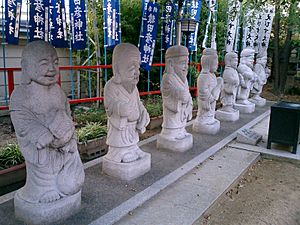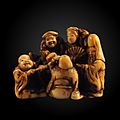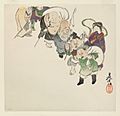Seven Lucky Gods facts for kids
The Seven Gods of Fortune, also known as the Seven Lucky Gods, are important figures in Japanese mythology and Japanese folklore. They are believed to bring good luck and happiness. You often see them in art, stories, and even small carvings called netsuke.
Contents
Meet the Lucky Gods
Each of these seven gods has a special role and a unique characteristic.
Ebisu
Ebisu is the god of fishers and merchants. He is often shown holding a cod or sea bass. He brings good fortune in business and fishing.
Daikokuten
Daikokuten, or Daikoku, is the god of wealth, trade, and commerce. He is often paired with Ebisu. You might see their images on the walls of small shops.
Bishamonten
Bishamonten is the god of warriors. He protects people and brings good luck in battle. He is often shown in armor, ready for action.
Benzaiten
Benzaiten, also called Benten-sama, is the goddess of knowledge, art, and beauty. She is especially known for music. She brings creativity and wisdom.
Fukurokuju
Fukurokuju is the god of happiness, wealth, and a long life. He is often shown with a very long forehead, symbolizing wisdom.
Hotei
Hotei is the fat and happy god of abundance and good health. He is often seen smiling and carrying a large bag. He brings joy and good fortune.
Jurōjin
Jurōjin, sometimes called Gama, is the god of long life. He is often shown with a deer, which is a symbol of longevity.
Where Did They Come From?
Most of the Seven Lucky Gods came to Japan from other countries. Many of them originated in China, and some even came from India before that. Only Ebisu is originally from Japan. Sometimes, another goddess named Kichijōten, who brings happiness, is shown with the seven gods. She might even take the place of Jurōjin in some stories.
The Treasure Ship
The seven gods are often pictured together on their special ship, called the Takarabune (which means "Treasure Ship"). According to tradition, the Seven Lucky Gods arrive in towns on New Year's Day. They bring wonderful gifts to people who are worthy. Children in Japan sometimes receive red envelopes with pictures of the Takarabune. These envelopes often contain money as a New Year's gift. You can see the Takarabune and the gods in many different kinds of art.
The Lucky Gods in Pop Culture
The Seven Lucky Gods have inspired many stories and characters in modern entertainment.
- They appear in the video game Pocky & Rocky 2 for the Super Nintendo.
- The main villains in the Ranma 1/2 movie Big Trouble in Nekonron, China are called the Seven Lucky Gods Martial Artists. Their characters are based on the gods, but they have different names.
Images for kids
-
Seven Lucky Gods by Hokusai et al.
-
Coloured woodblock print of the Takarabune by Utagawa Hiroshige
-
The Seven Lucky Gods in a woodblock print by Utagawa Kuniyoshi
-
The Seven Lucky Gods, in an 1882 print by Tsukioka Yoshitoshi.
See also
 In Spanish: Siete Dioses de la Fortuna para niños
In Spanish: Siete Dioses de la Fortuna para niños








